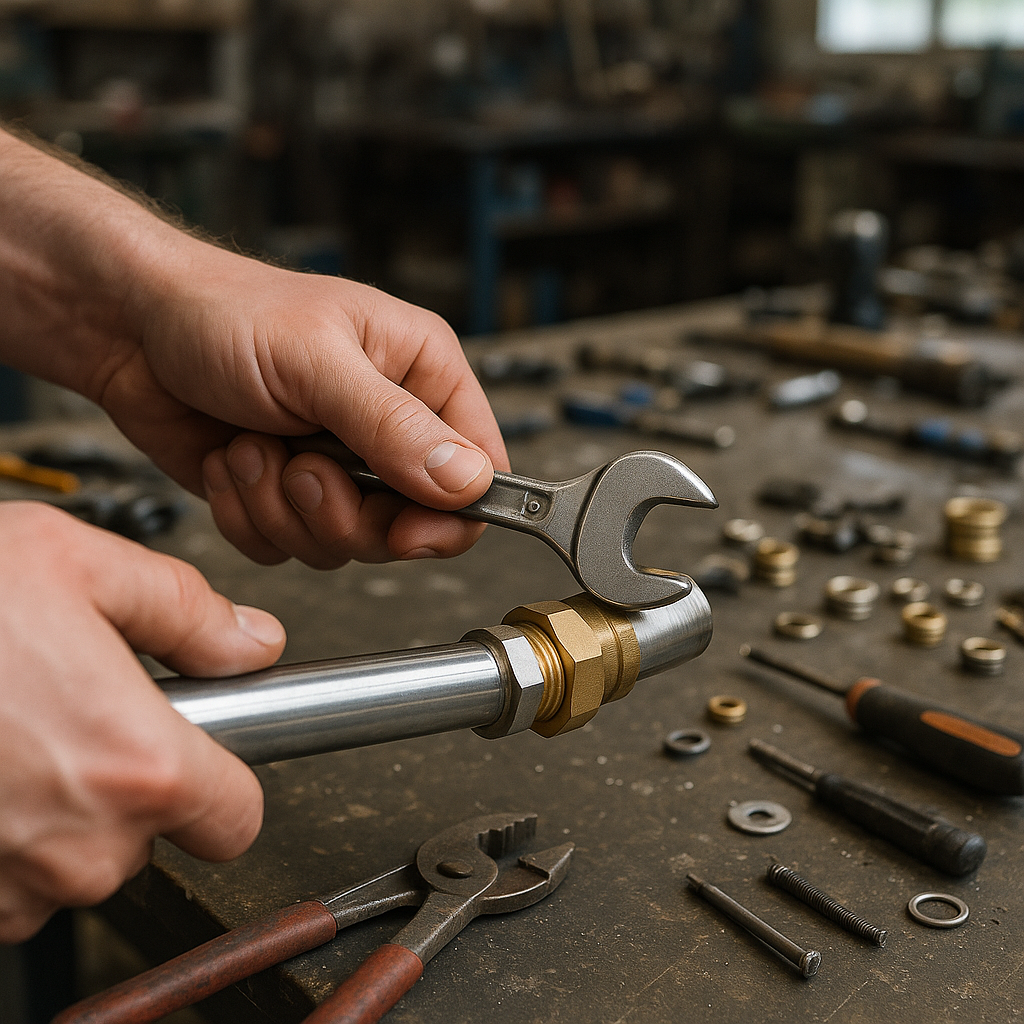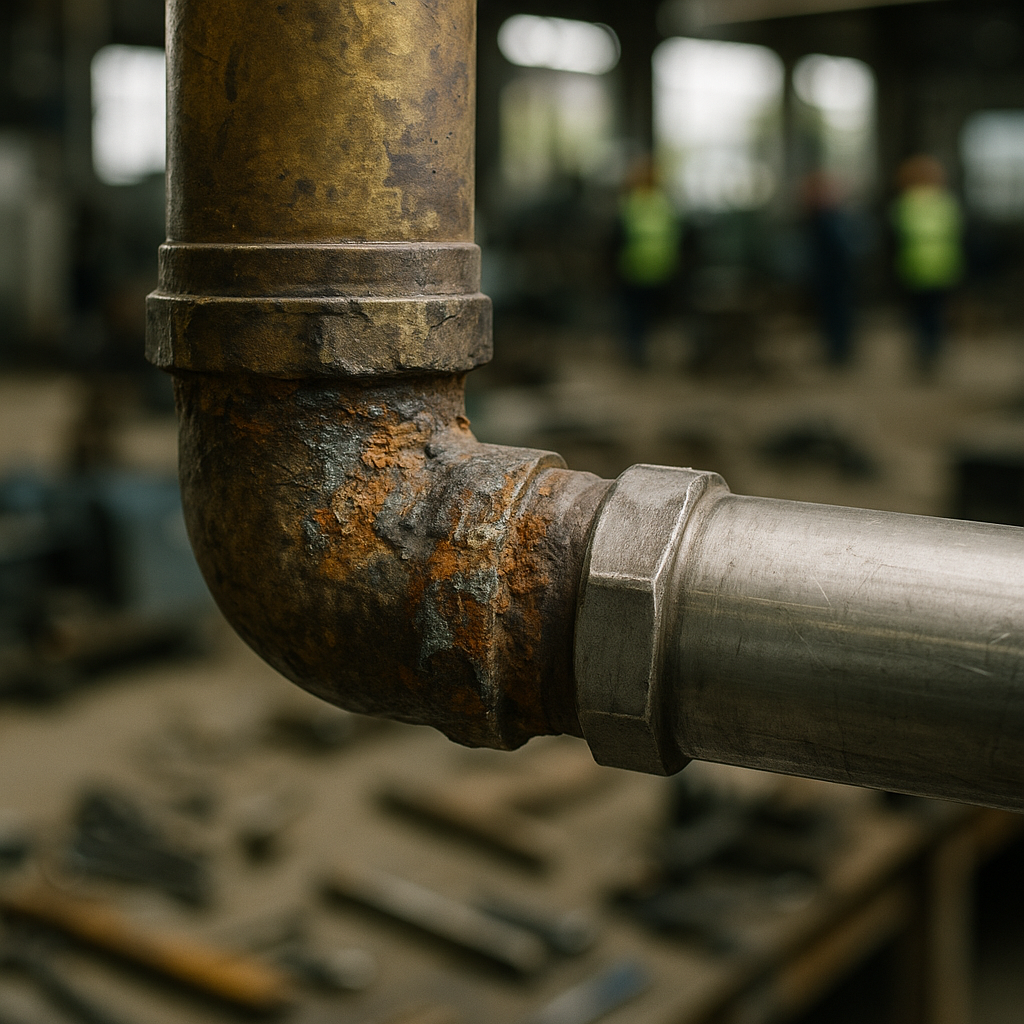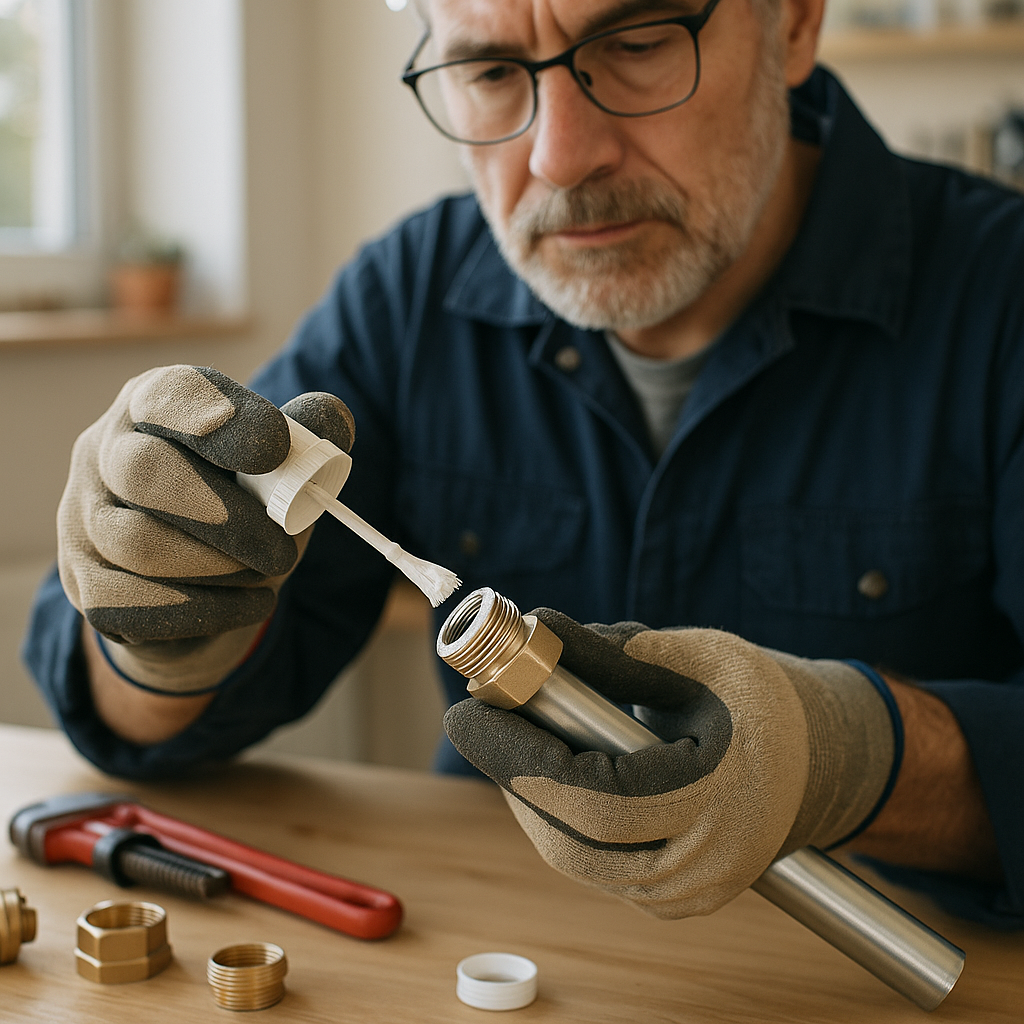5901 Botham Jean Blvd, Dallas, TX 75215
Discover the Key Differences Between Stainless Steel and Brass
September 16, 2025Choosing between stainless steel and brass requires an understanding of their fundamental differences. These two metals serve distinct purposes in recycling operations and various industrial applications due to their unique compositions and properties.
Stainless steel consists primarily of iron with chromium (at least 10.5%) and other elements such as nickel. Brass, on the other hand, is an alloy made from copper (60-70%) and zinc (30-40%). This basic compositional difference drives most of their contrasting characteristics.
Stainless steel offers superior strength with tensile ratings between 500-1100 MPa compared to brass at 340-470 MPa. This makes stainless steel the preferred choice for structural components that must withstand heavy loads, as brass lacks the same durability under high-stress conditions.
How Can Stainless Steel and Brass Be Joined?

Joining stainless steel to brass is challenging due to the differing properties of these metals. Brazing offers an effective solution for creating strong, durable bonds while maintaining the integrity of both materials. Understanding the correct techniques and materials is essential for achieving successful joints.
The Challenge of Joining Dissimilar Metals
Stainless steel and brass expand at different rates when heated, with brass expanding more rapidly. This can create fitting issues during brazing. Proper clearance between components is crucial for a successful joint.
When joining these metals, the difference in expansion must be considered. If brass fits into stainless steel, additional initial clearance (approximately 0.003-0.005 inches) is needed for proper gap at brazing temperature. Conversely, when stainless steel fits into brass, a tighter fit can be used since brass will expand more when heated.
Selecting the Right Brazing Materials
Using the correct brazing rod and flux is critical for joining stainless steel and brass:
- Silver-based filler metals like SSF-6 (approximately 45% silver content) create strong bonds between stainless steel and brass.
- Active fluxes designed for stainless steel, such as those containing fluorides, are necessary to break down the chromium oxide layer on stainless steel.
- Standard brazing fluxes often do not provide sufficient chemical activity for stainless steel joints.
The higher silver content in brazing rods helps bridge the gap between these dissimilar metals and flows effectively at lower temperatures than standard brazing materials, reducing the risk of damaging the brass component.
Step-by-Step Brazing Process
Follow these steps for successful stainless steel to brass brazing:
- Thorough Cleaning: Remove all oils, greases, and oxides from both metal surfaces. Start with degreasing solvents for oils, followed by mechanical or chemical cleaning for oxides.
- Joint Design: Create a joint with proper clearance (typically 0.002-0.003 inches at brazing temperature) to allow capillary action to draw the filler metal through the entire joint.
- Apply Flux: Coat all joint surfaces completely with a stainless steel-compatible flux. Apply flux to the brazing rod as well to improve flow.
- Assembly and Support: Position parts correctly and support them to maintain alignment during heating. Use fixtures made of materials that won’t conduct heat away from the joint area.
- Heating Technique: Heat the stainless steel component first and more intensely, as it requires higher temperatures than brass. Direct the flame onto the stainless steel rather than the brass to prevent overheating.
- Apply Filler Metal: Once the flux turns clear (around 1100°F/593°C), touch the silver brazing rod to the joint. The metal should flow naturally into the joint through capillary action.
- Allow Natural Cooling: Let the assembly cool naturally to prevent thermal stress that could weaken the joint.
- Clean Thoroughly: Remove all flux residue by quenching in hot water while still warm (but after the filler metal has solidified). For stubborn flux, use a 25% hydrochloric acid solution.
Common Challenges and Solutions
Several issues can arise when brazing stainless steel to brass:
If the brass component begins to melt before proper brazing occurs, it indicates excessive heat application. Focus more heat on the stainless steel side and use a larger torch tip to distribute heat more evenly across larger components.
Poor filler metal flow often results from inadequate cleaning or insufficient flux. Ensure surfaces are meticulously cleaned and apply fresh flux to the brazing rod if the operation takes longer than expected.
For larger diameter pipes (3 inches or more), standard equipment may be insufficient. Use a larger oxy-acetylene setup with appropriate tips to provide adequate heat distribution.
Testing Joint Quality
A properly brazed stainless steel to brass joint should show a continuous fillet of filler metal around the joint perimeter. The filler metal should appear smooth and well-flowed, without excessive buildup or gaps. For critical applications, pressure testing can verify joint integrity before putting the assembly into service.
With proper technique and materials, the bond between stainless steel and brass can be as strong as the parent materials themselves, providing reliable service even in demanding applications.
| Metal | Thermal Expansion Coefficient (10-6/K) | Thermal Expansion Coefficient (10-6/°F) |
|---|---|---|
| Brass | 19.4 | 10.8 |
| Stainless Steel (300 series) | 16.0 | 8.9 |
| Stainless Steel (400 series) | 11.0 | 6.1 |
| Copper | 16.5 | 9.2 |
What Are the Potential Issues When Mixing Stainless Steel and Brass?

Mixing stainless steel and brass components in recycling operations can lead to several complications affecting system integrity and efficiency. Galvanic corrosion is the primary concern when these dissimilar metals contact moisture or other electrolytes.
This corrosion occurs because stainless steel and brass are positioned differently on the galvanic series. In this electrochemical relationship, brass typically becomes the anode (more vulnerable material) while stainless steel acts as the cathode, creating an electrical potential that accelerates corrosion in brass. The severity depends on the specific grades of stainless steel involved.
For example, brass fasteners on stainless steel sorting equipment in recycling facilities can deteriorate rapidly when exposed to humidity or water used in processing. Corrosion often appears as a groove or localized material loss where the metals meet, compromising structural integrity over time.
Threading issues present another challenge. Stainless steel’s greater hardness than brass can lead to complications during assembly and disassembly. This hardness differential can cause galling—wear from adhesion between sliding surfaces—especially in threaded connections. Technicians often report brass threads stripping or deforming when combined with stainless steel fittings under high torque.
Sealing problems also arise due to the different expansion rates of these metals. Brass has a higher thermal expansion coefficient than stainless steel, causing uneven expansion and contraction during temperature changes. In recycling equipment exposed to variable temperatures, this can compromise gasket seals at connection points, leading to leaks.
Compatibility between specific alloys is crucial when using these metals together. The risk of problematic interactions varies with the exact composition of each metal. For instance, brass and 301, 304, and 310 stainless steels typically have a small electrical potential difference (within 0.25V), making them relatively compatible. However, pairing brass with 410 stainless steel creates a larger potential difference, significantly increasing corrosion risk.
To mitigate these issues, several practical strategies can be implemented in recycling operations:
- Use insulating materials between the metals to break the electrical connection. Non-conductive washers, bushings, or gaskets can effectively prevent direct contact.
- Apply protective coatings to the cathode (stainless steel), rather than the anode (brass). If a coating on stainless steel becomes damaged, it won’t accelerate brass corrosion.
- Ensure the anodic component (brass) has a substantially larger surface area than the cathodic component (stainless steel) to reduce corrosion intensity.
- Select compatible grades when possible. Choose stainless steel variants closer to brass on the galvanic series.
- Use appropriate lubricants or anti-seize compounds on threaded connections to prevent galling and facilitate disassembly.
In waste processing environments where moisture is unavoidable, electrical isolation is crucial. Proper design considerations during the planning stage can prevent costly equipment failures and maintenance issues. Ensuring dry connection points through appropriate sealing measures provides additional protection against galvanic reactions.
For recycling facility operators dealing with mixed-metal systems, regular inspections of stainless steel and brass component connection points should be part of maintenance schedules. Early detection of corrosion indicators allows for timely intervention before structural integrity is compromised.
| Stainless Steel Type | Anodic Index Difference with Brass (V) | Compatibility Level |
|---|---|---|
| 301 | 0.15V | Good |
| 304 | 0.20V | Moderate |
| 310 | 0.25V | Moderate |
| 316 | 0.30V | Poor |
| 410 | 0.35V | Poor |
By understanding these potential issues and implementing preventive measures, recycling operations can effectively integrate both stainless steel and brass components while minimizing corrosion risks and extending equipment lifespan.
What Are the Best Practices for Using Stainless Steel and Brass Fittings Together?

When combining stainless steel and brass fittings in plumbing or hydraulic systems, it’s crucial to understand the risks of galvanic corrosion. The difference in electrical potential between these metals can lead to accelerated corrosion if they contact an electrolyte like water. Employing the right preventive measures ensures durable connections.
Understanding the Anodic Index
The anodic index measures the electrical potential of metals. When connecting different metals, their position on this scale indicates corrosion risk. Safe combinations typically have an anodic index difference not exceeding 0.15V to 0.25V.
Not all stainless steel grades work equally well with brass. Grades 301, 304, and 310 have a minimal anodic difference from brass, making them suitable choices. In contrast, 410 stainless steel is significantly different from brass on the anodic index, posing a high galvanic corrosion risk.
Selecting Compatible Materials
When choosing materials for your system, consider these compatibility factors:
- Use stainless steel grades 301, 304, or 310 with brass for a minimal corrosion risk
- Avoid 410 stainless steel when connecting to brass components
- For harsh environments with chloride or salt exposure, consider 316 stainless steel for its chemical resistance
- For dezincification-resistant applications, select DZR brass fittings instead of standard brass
Isolation Techniques
Physical barriers prevent direct metal-to-metal contact, stopping galvanic corrosion before it starts. These methods help create electrical isolation between dissimilar metals:
- Install dielectric unions or insulating fittings between brass and stainless steel components
- Use non-conductive gaskets made from PTFE, nylon, or rubber at connection points
- Apply thread sealants like Teflon tape to create a barrier while ensuring leak-free connections
- Consider dielectric flanges for high-pressure or industrial applications
Proper Sealing and Installation
Correct installation significantly reduces corrosion risks. Follow these best practices:
Clean all surfaces thoroughly before assembly, as contaminants can accelerate corrosion or impede proper sealing. Use appropriate thread sealants that won’t increase conductivity. Avoid graphite-based compounds, which can enhance electrical conductivity.
Use anti-seize compounds specifically formulated for dissimilar metals to prevent galling and seizure while providing some electrical isolation. Maintain proper torque specifications during installation to prevent mechanical stress that could damage protective coatings.
Environmental Considerations
The operating environment significantly affects corrosion potential between brass and stainless steel. In high-moisture areas or underwater applications, galvanic corrosion accelerates. Chloride-rich environments, including coastal locations and swimming pools, increase corrosion risk.
Temperature fluctuations can affect the rate of galvanic reactions. Higher temperatures typically accelerate corrosion processes. Water quality also matters; soft water, low pH, and high chloride content all promote corrosion when dissimilar metals connect.
| Stainless Steel Grade | Anodic Index Difference with Brass | Compatibility with Brass |
|---|---|---|
| 301 | Small | Compatible |
| 304 | Small | Compatible |
| 310 | Small | Compatible |
| 410 | Large | Incompatible |
| 316 | Varies | Compatible in corrosive environments |
Maintenance Practices
Regular maintenance helps catch corrosion issues before they cause system failure. Inspect connection points regularly for signs of corrosion, including discoloration, deposits, or leakage. Look for blue-green deposits on brass or reddish discoloration as indicators of active corrosion.
Flush systems periodically to remove stagnant water that promotes corrosion. Consider water treatment options like corrosion inhibitors for closed systems. Document all connections in your system for future reference and maintenance planning.
Advanced Protection Methods
For critical applications or harsh environments, consider these additional protection strategies:
- Apply protective coatings like epoxy to brass surfaces to isolate them from the environment
- Use sacrificial anodes in systems where complete isolation isn’t possible
- Install water treatment systems to control pH and reduce corrosivity
- Consider composite or polymer-lined fittings in extremely corrosive environments
By following these best practices, you can use stainless steel and brass fittings together successfully while minimizing corrosion risks. The key lies in proper material selection, effective isolation, careful installation, and ongoing maintenance.
Conclusion: Making Informed Decisions When Working with Stainless Steel and Brass
Selecting the right metal for your application requires careful consideration of the unique properties of both stainless steel and brass. Stainless steel offers superior strength, excellent corrosion resistance in harsh environments, and higher heat tolerance, making it ideal for structural components and outdoor applications. Brass provides better conductivity, machinability, and aesthetic appeal with its distinctive golden hue, making it suitable for electrical components and decorative elements.
When managing these metals at the end of their lifecycle, remember that both materials are 100% recyclable, making them sustainable choices for environmentally conscious projects. Understanding their distinct properties aids not only in appropriate material selection but also in ensuring effective recycling processes. For specialized metal recycling needs or guidance on sustainable material choices, contact Okon Recycling at 214-717-4083.
